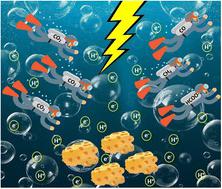当前位置:
X-MOL 学术
›
J. Mater. Chem. A
›
论文详情
Our official English website, www.x-mol.net, welcomes your feedback! (Note: you will need to create a separate account there.)
Recent trends in CO2 electroreduction over metal–organic framework-derived materials: a comprehensive review
Journal of Materials Chemistry A ( IF 10.7 ) Pub Date : 2024-08-25 , DOI: 10.1039/d4ta03502j Nadia Gholampour , Chizoba I. Ezugwua , Hussein A. Younus , Damien P Debecker , Mohammed Al-Abri , Rashid Al-Hajri , Jimmy Kao , Francis Verpoort
Journal of Materials Chemistry A ( IF 10.7 ) Pub Date : 2024-08-25 , DOI: 10.1039/d4ta03502j Nadia Gholampour , Chizoba I. Ezugwua , Hussein A. Younus , Damien P Debecker , Mohammed Al-Abri , Rashid Al-Hajri , Jimmy Kao , Francis Verpoort

|
Carbon dioxide reduction through electrochemical energy is an emerging and appealing approach towards CO2 mitigation, and it is a potential technique in which the current and faradaic efficiencies can be optimized for the efficient/effective conversion of CO2 to solar fuel (storable high-density chemical energy). However, a challenge associated with the current state-of-the-art electrocatalytic systems is developing efficient, selective, and cost-effective heterogeneous catalysts. In this case, materials derived from metal–organic frameworks (MOFs) are promising electrocatalysts that not only possess porous structures similar to their parent MOFs but are also endowed with improved stability and conductivity, which are required in the CO2 reduction reaction (CO2RR). This review surveys the updated strategies to rationally design efficient MOF-based electrocatalysts and MOF-derived materials for CO2 reduction. Various MOF-derived materials are comprehensively discussed, together with the strategies aimed at improving product selectivity. Furthermore, active sites and detailed underlying mechanisms of CO2 reduction are discussed to gain better insights into the future development of electrocatalysts. This investigation aims to highlight the recent advances in the CO2RR to inspire the development of new techniques in designing electrocatalysts based on MOF structures with high performance and high stability.
中文翻译:

金属有机骨架衍生材料 CO2 电还原的最新趋势:全面综述
通过电化学能减少二氧化碳是一种新兴的、有吸引力的 CO 2减排方法,它是一种潜在的技术,可以优化电流和法拉第效率,以高效/有效地将 CO 2转化为太阳能燃料(可储存的高密度燃料)。化学能)。然而,与当前最先进的电催化系统相关的挑战是开发高效、选择性和具有成本效益的多相催化剂。在这种情况下,源自金属有机框架(MOF)的材料是有前途的电催化剂,不仅具有与其母体MOF相似的多孔结构,而且还具有改善的稳定性和导电性,这是CO 2还原反应(CO 2 RR)。本综述调查了合理设计用于 CO 2还原的高效 MOF 基电催化剂和 MOF 衍生材料的最新策略。全面讨论了各种 MOF 衍生材料,以及旨在提高产品选择性的策略。此外,还讨论了CO 2还原的活性位点和详细的潜在机制,以便更好地了解电催化剂的未来发展。本研究旨在突出CO 2 RR的最新进展,以激发设计基于高性能和高稳定性MOF结构的电催化剂新技术的开发。
更新日期:2024-08-25
中文翻译:

金属有机骨架衍生材料 CO2 电还原的最新趋势:全面综述
通过电化学能减少二氧化碳是一种新兴的、有吸引力的 CO 2减排方法,它是一种潜在的技术,可以优化电流和法拉第效率,以高效/有效地将 CO 2转化为太阳能燃料(可储存的高密度燃料)。化学能)。然而,与当前最先进的电催化系统相关的挑战是开发高效、选择性和具有成本效益的多相催化剂。在这种情况下,源自金属有机框架(MOF)的材料是有前途的电催化剂,不仅具有与其母体MOF相似的多孔结构,而且还具有改善的稳定性和导电性,这是CO 2还原反应(CO 2 RR)。本综述调查了合理设计用于 CO 2还原的高效 MOF 基电催化剂和 MOF 衍生材料的最新策略。全面讨论了各种 MOF 衍生材料,以及旨在提高产品选择性的策略。此外,还讨论了CO 2还原的活性位点和详细的潜在机制,以便更好地了解电催化剂的未来发展。本研究旨在突出CO 2 RR的最新进展,以激发设计基于高性能和高稳定性MOF结构的电催化剂新技术的开发。





































 京公网安备 11010802027423号
京公网安备 11010802027423号